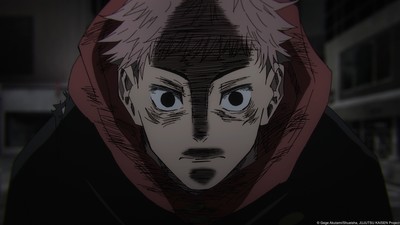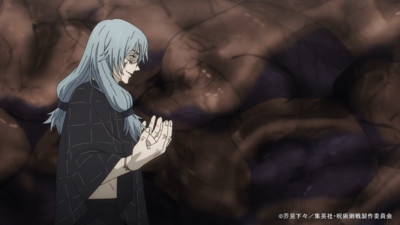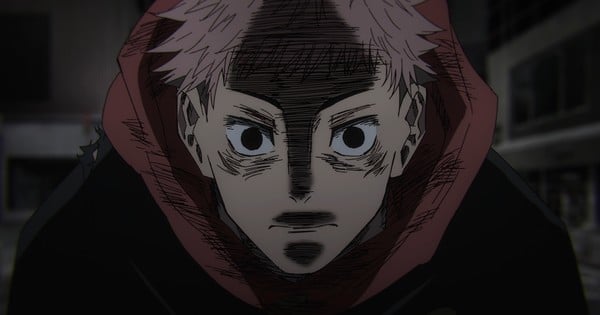Nicky and Nick look at the production issues at Jujutsu Kaisen studio MAPPA following several social media posts from animators working there.
Disclaimer: The views and opinions expressed by the participants in this chatlog are not the views of Anime News Network.
Spoiler Warning for discussion of the series ahead.
Warning: this article contains statements about suicidal ideation. If you or anyone you know is suicidal or having suicidal thoughts, please reach out to a suicide prevention organization in your country. In the United States, the National Suicide Prevention Lifeline is available at 1-800-273-8255. In Japan, the TELL LifeLine service is available at 03-5774-0992, and an English counseling service is available at 03-4550-1146. In Canada, Crisis Services Canada is available at 1-833-456-4566.
Nick
Nicky, ever since season two of
Jujutsu Kaisen was announced, people have hyped up the Shibuya Incident Arc. It’s been compared to some of the greatest story arcs in battle shonen history and promoted as one of the year’s biggest events, and manga fans have been singing its praises to the point you’d think it cured multiple diseases just by existing. So the question is, does it live up to the hype?

Unfortunately for our readers, we are not here to answer that question. Instead, we’re here for an excruciating discussion about the depressing reality of the art we love being made at the cost of needless human suffering for profit margins. Welcome to the ultimate Buzzkill TWIA.
Nicky
I’ve been WAITING for the chance to gush about
Jujutsu Kaisen‘s second season’s fantastic animator showcase, but instead, I’m here to talk about something far more sinister and darker than the events of the Shibuya Incident. That is the alleged horrors at
JJK’s main production studio,
MAPPA.
It’s not the first time we’ve covered the industry in the column, and it certainly won’t be the last. Previously, Steve and I lamented how
dream jobs become nightmares with
Zom 100.
Folks may know
MAPPA from the many shows they’ve produced in the past few years, including hits like
Vinland Saga and
Attack on Titan. You may know the name from the thousands of teenagers on Twitter who have been yelling “
MAPPA GOATED” every 30 seconds. They are a prominent and prolific part of the anime industry, and if social media posts by
JJK animation director
Itsuki Tsuchigami are anything to go by, working for them sucks major ass. Things started to kick off on September 30, when Tsuchigami
tweeted that
MAPPA is “a mess” and warned animators looking to do their best should avoid working there.
The praise for anime made under
MAPPA isn’t unwarranted, though. They have produced hit after hit with
Chainsaw Man,
Hell’s Paradise,
Jujutsu Kaisen, and all big blockbuster adaptions of popular battle manga. The animators working with
MAPPA know how to pull out all their stops to meet fans’ high expectations. Most people expect something made under bad conditions to look inadequate or shoddy. Astonishingly, some of our favorite anime were hell to work on.

MAPPA is not alone in the industry when it comes to awful working conditions. We are in an unprecedented era of over-production, with studios being pushed to finish projects on wholly unrealistic timelines and having to either crunch, outsource, or interminably delay their release to compensate.
MAPPA‘s recent struggles with
JJK’s production have garnered a ton of attention because they’re working on such a high-profile show and how extremely outspoken the staff have been about their awful working conditions. Though
MAPPA‘s higher-ups would purportedly like to
eliminate that second part.

If workplace conditions are so poor, why don’t we ever hear about it? NDA is standard practice for video games and animation in the West but is rarely publicly spoken about regarding anime productions. Most animators working in anime are freelancers working on a contract basis. Whether or not you eat in the anime industry depends on your connections. We’re seeing recruiters use social media to discover and contact talent, so any visible smack talk is a considerable risk, and bad-mouthing one of your employers is a sure way to get blacklisted. In addition, Japan also has
severe criminal laws regarding defamation, making the repercussions of any remarks considered not of public interest very serious. With the existing consequences, allegedly attempting to further silencing animators with an NDA would be a cruel act on
MAPPA‘s part. Any artist who deigns to speak out is already taking a huge risk.
It speaks to just how bad it would have to be there. I imagine it is incongruous to the average viewer when
JJK’s latest season has largely looked very good. However, that’s also the issue.
MAPPA appears to encourage—or demand—high-level action spectacle for its projects to build its reputation, and it’s an effective marketing strategy. Even though the actual people making the damn thing are saying it’s a miserable, demoralizing experience, without that being directly reflected by the on-screen product, in as obvious a fashion as possible, the message a lot of viewers will get is “Wow, awesome animation.” That exact thing happened with an episode that was quite visibly unfinished two episodes ago.


It doesn’t screencap well, but those are storyboards being panned and faded over rather than a completed animation cut. It’s essentially an animatic put into the episode because it wasn’t finished.
Even in the West, which has its industry issues, NDAs aren’t supposed to be used to cover up unfair treatment or crimes. However, just like any abuse, it’s challenging for others to speak out when they’re already struggling. When it’s a systematic issue like the anime industry, it’s much easier for the powerful to eliminate anyone who decides to run their mouth. The fact that many animators have been voicing their discontent underscores how serious the situation has been.
MAPPA animator Sōta Shigetsugu wrote that JJK season two’s schedule wasn’t adjusted because the staff managed to pull off the impossible feat of finishing a movie in four months.

Shigetsugu also shared a cut of animation where they said they used MAPPA‘s studio as a reference for an area that gets destroyed in JJK. Supposedly the rest of the staff enjoyed it.
Yeah, that is just goddamn jaw-dropping. Four months to complete a fully animated feature-length production is insane to a degree I don’t have the vocabulary to communicate. That MAPPA executives allegedly took that as a point of pride to shop around to producers is one of those moments where you wish you could make people’s eyeballs and testicles switch places.
As a reference point, most animated theatrical films take
four to seven years to complete, not months! Even if we exclude all the time most films spend in pre-production, drawing isn’t a linear task. Unlike the average desk job, creative work can be a whole body-and-mind process involving a lot of trial and error that can only be achieved through skill and time. This makes tight turnarounds without any consideration or flexibility for extensions particularly harsh. I will also note that it’s very ironic this season had a fighter whose entire power is using cel animation because I’ve never related so hard to a grumpy old geezer before.


Ironically, the episode with that old fart’s lecture is also where the production’s seams started to burst in front of the audience’s eyes. The battle in Dagon’s domain was noticeably stiffer than anything before it, with several visibly cut corners endemic to an ambitious vision that had to be drastically scaled back at the last minute because it wasn’t feasible to get it done by the deadline. The result isn’t terrible, relative to current TV productions, but the apparent compromises were enough that episode director
Hokuto Sadamoto was actively apologizing on social media about it.
Judging animation quality is, of course, a subjective endeavor. Some people dislike too loose or rough animation, but it can be an interesting means of both stylization and effective means of portraying action. There’s been a rise in animators that utilize more freeform styles. Some viewers may also not notice the rougher parts of production or find them more forgettable in favor of other stand-out moments like in episode 40, “Thunderclap.” This episode, directed by
Itsuki Tsuchigami, features two major showdowns side-by-side and a smorgasbord of sakuga from many talented individual animators. It stands as one of the series’ best episodes.

This is ironic, given how much of a disaster the next episode is! Animator
Enrico Nobili described the episode as
unfinished in a now-deleted Tweet last week and only ” 30% of the intended vision.”
It’s bizarre to see those two “Thunderclap” episodes side by side. They were envisioned as back-to-back super spectacles, a flex to show they could pull off something like
Mob Psycho 100 II‘s famous fifth episode in back-to-back releases. And to most folks, I imagine they succeeded. “Thunderclap, Part 2” is undoubtedly filled with stylish, memorable cuts. Yet the constraints of its creation are still visible. Outside of the animatic climax, there’s a severe lack of cohesion between individual sequences, which turns the episode-long fight into visual noise. Not to mention the visibly incomplete compositing for backgrounds and environments.


Part of this is that Part One was produced way ahead of the other episodes. According to Tsuchigami, Part 2 was presumably part of regular production, meaning it likely didn’t receive nearly as much time or attention. It’s evidence that time does make all the difference.


However, in response to the praise for his work, Tsuchigami notes that the pay for the job was “nothing special” compared to other big jobs. Besides
JJK, Tsuchigami has been a creative talent on
Mob Psycho 100,
Attack on Titan, and
My Hero Academia.

Considering how often I’ve seen producers (and sometimes writers) say that animation is great because it costs the same to draw anything, that tracks. It also speaks to the little compensation for stellar animation work outside of personal pride and accolades from one’s peers, which makes the idea of having to force out unfinished material just that much worse.
The point I’d like to illustrate most is that workplace conditions don’t always reflect in the end episode. Just like how bad people can be great musicians and the disappointment of finding out your favorite singer sucks as a human being. The fact that the season has held up so far is astounding, but where it differs is that a corporation, like a studio, isn’t a person. The execs deciding the deadlines and the pay aren’t the ones doing the work. It’s all the individual artists who try hard despite everything. People who care deeply about making something others can enjoy have the most reason to feel dissatisfied with a lousy product.

I imagine at least some response for JJK’s most invested fans will be that, so long as the episodes look good (though I think the latest episode kind of puts that premise into question), then why should viewers care? Realistically speaking, we can’t influence much change in how MAPPA operates outside of populating hashtags on social media. For a show as mainstream as JJK, the average viewer probably can’t read a lick of Japanese, and the extent of their knowledge about the anime staff probably stops about three names after the director. So long as they get their show and it reaches their pre-determined expectations of hype sakuga, they can post gifs of it.
We have a unique position as anime fans. We’re consumers of a foreign country’s media. There are so many barriers to sending a message overseas, so it’s hard to imagine that any action we take could have a tangible impact. While some individuals might feel better avoiding MAPPA anime altogether, it’s one studio in a whole industry that’s just as bad. A lot would have to be done on a large scale to solve the existing issues. Currently, animators get little training, little support, and make little money.
My biggest advice is to divest oneself from impulsively prescribing insufficient production to laziness or incompetence when noticing that kind of thing. Nobody goes into making anime because they think it’ll make them rich, and they certainly don’t turn in a deficient creation because they couldn’t be bothered to try harder or whatever. Even if you can’t recognize artists or animators on sight, memorize names, or even learn about the business or process behind the stuff you watch, having basic solidarity for the actual people putting themselves into the stuff that speaks to you is a worthwhile place to start.
Agreed, we shouldn’t underestimate what little things we can do. I think the way the community bounded together to try and spread awareness of these injustices and vocalized support towards the staff was amazing. We couldn’t have put together this column without you guys. I worried about what kind of harassment or trouble the artists might face by sharing their statements, and I beg that you all treat them with the respect they deserve for speaking out. Moreover, you could do them a favor by checking out their accounts and seeing what cool art they’ve made. Several artists also have links to where you can send them money, subscribe, or take commissions, allowing you to support them directly. Doing this might create a positive environment where artists feel safe, secure, and appreciated. I’ll start us off; here is a cut from episode 41, where the Shigetsugu states he had a lot of fun working on it.
Despite mismanagement, I’m glad he managed to find some joy in the process. Though I hope somebody who worked on episode 42 can explain why Yuji and Mahito’s big faceoff had to take place in the Poop Hallway.


I can’t prove that was a consequence of a looming deadline, but I feel more time would have let somebody involved question that color choice.
It could just be a creative choice. Even an ideal world can’t account for everyone’s tastes in hallways, but it would be one where artists don’t have to feel like poop or be treated like it. We hear so much about anime with bad work conditions; I would love to hear more about studios that treat their employees right and for existing studios to be more transparent. The goal isn’t always to get better art; it is just that art is valued in a sustainable and healthy way for everyone making it.

Ironically,
MAPPA‘s CEO, Manabu Otsuka, referenced such a studio in an interview not too long ago. According to him, he started pushing for the studio to take on big-name adaptations because he wanted to establish them to stand alongside
Kyoto Animation. This is deeply funny in a very dark way because everything he’s done is the
opposite of that company’s ethos.
KyoAni is famous within the industry for fostering talent through their animation school and keeping that talent by engaging in healthy long-term plans that produce high-quality animation at a pace that doesn’t suck the life out of their staff. They are near completion of the latest
Sound! Euphonium series nearly half a year before it starts to air. If Otsuka’s appreciation of their work is sincere, he’s nonetheless learned the exact wrong lesson in trying to rival them.
The irony extends to
MAPPA‘s entire history. Former CEO
Masao Maruyama co-founded
MAPPA after being dissatisfied with the situation at his previous studio,
Madhouse.
MAPPA started as a boutique studio dedicated to niche projects and was very different from
Madhouse. He used the clout and experience he built throughout his long career to pull valuable names and talent. However, that vision has gradually eroded with more and more projects, and now it feels like
MAPPA is indistinguishable from the
Madhouse they were trying to escape. Recently, Maruyama founded a smaller studio named
M2 to produce artier fare, the studio responsible for the adaption of
PLUTO.
Again, this isn’t to single out
MAPPA as The One Studio That Does This, but it does highlight how backward the executive brain can get. When you see a studio lauded for being selective with its projects and dedicating its resources to fostering talent, and you decide the best way to emulate it is to create a content assembly line staffed with increasingly unhappy freelancers, you have already defeated yourself.
Jujutsu Kaisen‘s primary animator,
Kōsuke Katō briefly
tweeted last week that he was considering suicide.
As a longtime anime fan, I think the number of studios that haven’t been called out is dwindling. Even more niche studios like WIT or
Science SARU have had some allegations thrown at them regarding overwork and underpaying. Studios have yet to find a good funding model. When
Osamu Tezuka founded Mushi Pro to produce
Astro Boy, he would supply half the production cost with his own money. He still had to have people go without pay because paying people to draw is expensive and time-consuming.
It’s the sort of conundrum that makes you wonder about a system where artistic creation and expression aren’t attached to a profit motive like a toddler trapped in the jaws of a hungry bear. Unfortunately, until we overthrow capitalism and establish a socialist state based entirely around cool anime, our options are limited, and we’re likely to keep getting stories like this from somewhere.
I feel complicit for liking anime, knowing people suffer to make it. It’s tough to see an awesome anime, but then see situations like Kato’s tweet about wanting to die and feeling just a little responsible for potentially jeopardizing someone’s safety and well-being. Yet, I remind myself time and time again that there’s nothing wrong with appreciating art. My appreciation is why I’m here. I love anime so much that I want to see anime studios be held accountable. Watching anime doesn’t mean looking the other way.

Circumstances like this need viewers to be attentive, critical, and engaged with what they’re experiencing. The dream of executives who do this is for their consumers to uncritically eat up what’s put in front of them and not think about it. I called this a buzzkill TWIA because it’s a fucking bummer, but it’s still important. You should care about the people behind the stuff you like. You should want them to be given the best conditions possible to develop and express themselves. You should think about this stuff even if—and because—it sucks!
Most importantly, you should e-mail Manabu Otsuka and ask him about the turd hallway.






















